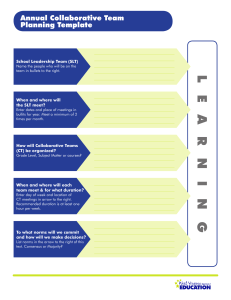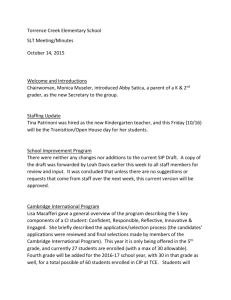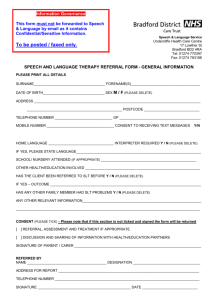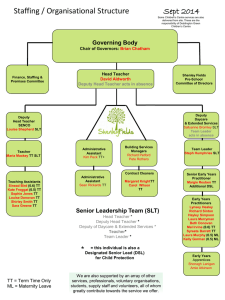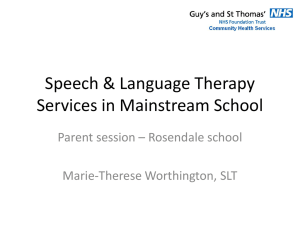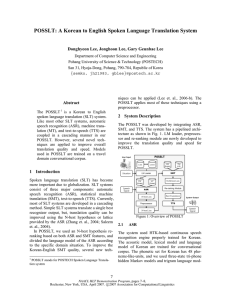Theoretical and methodological and issues regarding the use of Language Theoretical
advertisement
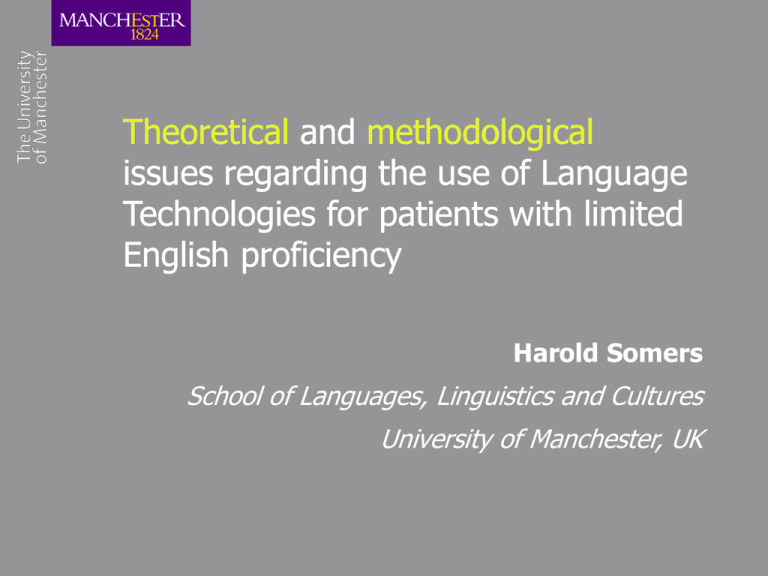
Theoretical and methodological issues regarding the use of Language Technologies for patients with limited English proficiency Harold Somers School of Languages, Linguistics and Cultures University of Manchester, UK Overview • Background: PLEPs and LT, especially Medical SLT • Different users, different scenarios – Pathway to healthcare – Language technology • SLT or other (lesser) technologies? • Some experiments with lo-tech solutions • Conclusions 2 Background: PLEPs and LT • Huge literature on language barrier problems for Patients with Limited English Proficiency … • … and their doctors/healthcare providers • Traditional solutions (interpreters etc.) expensive, not available on demand; or (amateurs) unsuitable • Focus on spoken language translation (e.g. Medical SLT workshop at NAACL) is good, but perhaps too narrow 3 Pathway to Healthcare Initial advice seeking Doctor seeks information Rx Making an appointment Providing general background information Doctor-patient consultation Doctor explains pro-/diagnosis Procedures with nurse Follow-up visits 4 Different users, different scenarios • Patient must communicate with … – Receptionist – Paramedic – Doctor • GP Healthcare provider • Specialist – Nurse – Pharmacist 5 Role of language in pathway to healthcare Initial advice seeking Making an appointment Information retrieval/QA Cooperative task-based dialogue Gathering background information Doctor-patient consultation At the pharmacist Procedures with nurse Follow-up visits Form-filling Multi-purpose dialogue etc Reading instructions Following instructions Any of the above 6 • Do we want a single device for all these scenarios? • Who is the principle user of the device(s)? – Healthcare providers will see many patients with differing levels of LEP, and of course different native languages – Viewed from patient’s perspective, there is more consistency 7 Assumed profile of users • Assumption that one of users is a healthcare provider – L1 user may be more or less educated, qualified, medical: doctor, nurse, pharmacist, receptionist, orderly, etc. • Assumptions about who initiates and controls the dialogue and therefore who controls the software – Transonics: assumes the doctor wants to maintain control, has sole access to the controls, has greater technological familiarity 8 Users should “share” the tool • “Patient-centred” medicine (Stewart et al. 2003) • side-by-side rather than face-to-face • use of computers can be positive (Mitchell & Sullivan 2001) despite doubts • some patients (and doctors) may be suspicious or timid faced with unfamiliar technology, but our experience is that many aren’t 9 LT implications • Spoken language translation • Text translation • Multilingual information extraction • Text simplification • Computer-based interviewing • Speech recognition All of these typically for underresourced languages • Speech synthesis 10 Spoken Language Translation • Historically focus has been on task-oriented dialogues • Doctor-patient dialogues is an “obvious” application • Several dedicated research efforts – Languages covered include both “major” and “lesser” languages (Farsi, Pashto, Thai) – Medical SLT workshop at HLT/NAACL 05 • Some reports of “pipeline” systems 11 Pipeline SLT • Concatenate commercially available ASR, text MT, SS • Con: Speech is not text • Pro: Quick and easy • Focus on integration and user interface • Restricted to “major” languages • Experiments to see – is it usable? – where is the weakest link? 12 Pipeline SLT • Experiment – Evaluate the three contributing technologies, and their combination – (Apart from SR): Given context, human judges asked to paraphrase what they think was said – Judges then score whether correct information was conveyed • In all experiments, results suggested it was usable for this app (>85% correct interpretation) • For J-E, MT was the weakest link • For C-E – SR weakest link – After training, MT was weakest link 13 Some other approaches • Technologies not available for less-resourced languages (LRLs) • SLT not necessarily the best way to go • Two examples and an aside – Dose labels on prescriptions – Lo-tech phrase-book approach to predictable dialogues – Faking SS and (even) ASR for LRLs 14 Dose labels on prescriptions • Pros: – MT-friendly task (like Meteo) – US legislation has made availability of translation a requirement – Label printing is already computerized • Cons: – Problem of pharmacists’ legal responsibility 15 Dose labels on prescriptions • If pharmacist won’t provide translation, could the patient? • Problem of inputting the source text … • … And (if user is illiterate) reading the translation 16 Dose labels on prescriptions (input) • We experimented with handheld OCR ~R Cai.Dms 0.1s is. PREDN~SOL@E Teaks i~’r A1 of 3) put ~dr”~ into the nostrils t~e1iio, -be taken Baily, reducing ile Diane tWiCE jalnis directedr’ ;er seven days as dire~liied bj yc’ur ~ucIjI-S THROB QNAY OGYS N~IS- li THIS ~E ~~ AFTER OPENLY NOT aII@. e. Fa_lo* Tie )~.~~IEU INiTRU~TIO~i ~”~ ‘ijIj’~i%::” 17 Dose labels on prescriptions (output) • Talking pill boxes already exist for patients with impaired vision, or memory • Could be used for PLEPs 18 Predictable dialogues: Low-tech approach • Phrase-book approach • Support initial consultation between practitioner (GP or asthma nurse) and Somali patient • Doctor’s interface is drop-down menu; selections are linked to recordings of Somali speech • Patient’s interface has pictures, text and recorded speech • We have piloted two variants: – lap-top with mouse pad – tablet PC with stylus 19 20 21 Results • 26 consultations • 9 clinicians • High satisfaction … • … Except where dialogue involved going off-script 22 Reliance on text with illiterate users • Crucial to all applications is SS and perhaps ASR • Not available with less-resourced languages • We have experimented with “fake” SS … • … and even fake ASR 23 Faking Speech Synthesis • Understandable speech can be generated using SS system for sufficiently similar language – “Similar” in phoneme set, doesn’t have to be a related language – E.g. We used German for fake Somali SS • Key is whether or not it is “usable” • i.e. better than nothing ! 24 Faking ASR • Much harder, but … • If situation is sufficiently controlled, we can get acceptable performance • We successfully used English ASR to recognize spoken Urdu – NOT speech-to-text, but identification of correct answer from a choice of 2~6 alternatives – Of course this is an easier task! 25 Conclusions • Apologies: not much of this is MT • My point is – MT is not necessarily the best solution – Even where it is, full SLT may not be necessary – Where it is, there are problems with lessresourced languages • Bottom-line: research should be problemoriented, not technology-oriented 26
